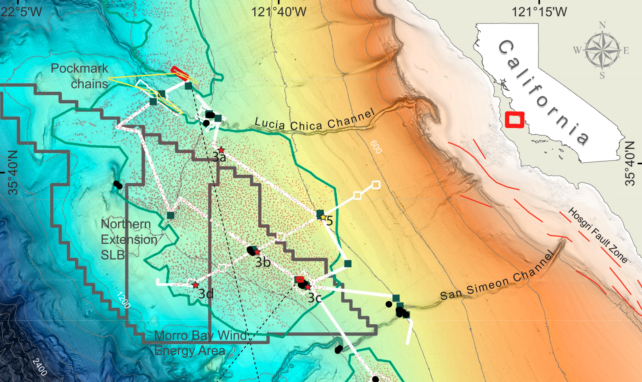Off the coast of Big Sur, California, deep beneath the waves lies a mysterious landscape riddled with large holes in the clay, silt and sand.
Decades after its discovery, scientists at the Monterey Bay Aquarium Research Institute (MBARI) and Stanford University believe they have figured out how the field’s strange circular pattern is created.
The generally accepted theory is that pockmarks on the seafloor are the product of methane gas or even hot liquids surging up from the Earth’s interior and blowing away fine sediments. While this is true for underwater depressions in some parts of the world, it is not always the case.
There are more and more exceptions to the rule.
The Sur Pockmark Field, off the coast of California, is the largest of its kind in North America. It is about the size of Los Angeles and contains more than 5,200 troughs, the average width of which is 175 meters (574 feet) and the depth of 5 meters (16 feet).
The site is earmarked for a potential offshore wind farm, but there have been concerns that the presence of methane could threaten the stability of the infrastructure.
On a recent expedition to the Sur pockmarks, which lie at depths of 500 to 1,500 meters, an underwater robot operated by MBARI researchers found “little evidence” of methane seeps or other fluid flows. Instead, the team believes that the pockmarks were likely caused by sheer gravity.
The large prints are located on a continental slope, and seafloor samples collected by the robot indicate that sediments have flowed down this slope intermittently for at least 280,000 years. The last major outflow occurred 14,000 years ago, possibly due to an earthquake or a slope collapse.
Researchers at MBARI argue that such events could cause erosion in the center of each pockmark. If a large enough amount of sediment rolls down, it may even cause “enough erosion” to chisel out a wider pockmark, shifting the edges of “multiple pockmarks several dozen kilometers apart,” the team suggests.
This could be why the pockmarks appear in “chains,” although future modeling is needed to confirm this idea.

“We collected a huge amount of data and were able to establish a surprising connection between pockmarks and sediment gravity flows,” says MBARI research technician Eve Lundsten.
“We were unable to determine exactly how these pockmarks originally formed, but with MBARI’s advanced underwater technology, we have gained new insights into how and why these features have persisted on the seafloor for hundreds of thousands of years.”
The Sur Pockmark Field is considered one of the most studied seabeds on the west coast of North America. But that doesn’t say much. Researchers still don’t know how sediments or fluids move across the field.
Until recently, experts didn’t know that it was porpoises and eels that created the smallest holes seen in a similar pockmark field in the North Sea.
frameborder=”0″allow=”accelerometer; autoplay; clipboard writing; encrypted media; Gyroscope; picture in picture; web-share referrerpolicy=”strict-origin-when-cross-origin”allowfullscreen>
The ocean floor is sometimes referred to as Earth’s final frontier. The race is on to scour this alien world, not just for scientific curiosity, but also for the feasibility of new industries like offshore wind farms or seabed mining. But it’s one thing to observe an ecosystem and quite another to understand it.
“Expanding renewable energy is critical to achieving the dramatic reductions in carbon dioxide emissions needed to prevent further irreversible climate change,” said Chris Scholin, president and CEO of MBARI.
“However, there are still many unanswered questions about the potential environmental impacts of offshore wind energy development. This research is one of many ways MBARI researchers are answering fundamental questions about our oceans to inform decisions about how we use marine resources.”
The study was published in Journal of Geophysical Research Earth Surface.